Managing People (BBS006-1): Stand4Socks Case Study Analysis Report
VerifiedAdded on 2022/08/16
|13
|2977
|11
Report
AI Summary
This report provides a detailed analysis of the Stand4Socks case study, a social enterprise facing financial instability and people management challenges. It begins with an executive summary and table of contents, followed by an introduction to employee management and its significance. The discussion section includes a brief overview of Stand4Socks, the identification of financial instability as the core business management issue, and a review of relevant management theories such as Frederick Taylor's scientific theory, Henri Fayol's administrative theory, Max Weber's bureaucratic theory, and Elton Mayo's human relations theory. The report then explores how these theories can be applied to the Stand4Socks case to improve efficiency and resolve financial issues. The conclusion summarizes the key findings, emphasizing the importance of employee management and the challenges faced by Stand4Socks. Finally, the report offers several recommendations for Josh Turner, the founder of Stand4Socks, including organizing and prioritizing payments to address cash flow issues, proper standardization of workplace rules and to ensure maximum efficiency in the business. The report is well-structured, referencing relevant academic sources to support its analysis and recommendations.
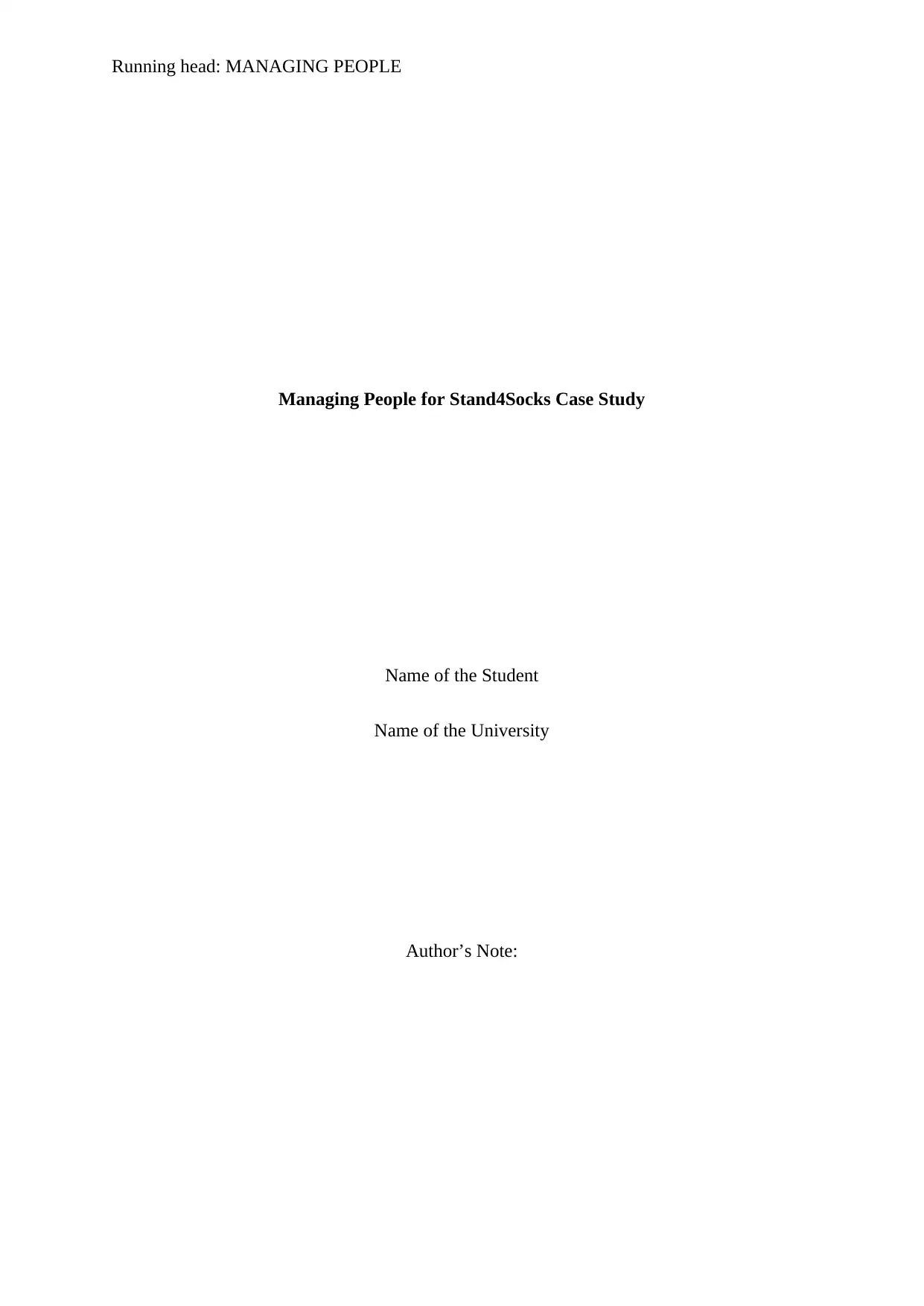
Running head: MANAGING PEOPLE
Managing People for Stand4Socks Case Study
Name of the Student
Name of the University
Author’s Note:
Managing People for Stand4Socks Case Study
Name of the Student
Name of the University
Author’s Note:
Paraphrase This Document
Need a fresh take? Get an instant paraphrase of this document with our AI Paraphraser
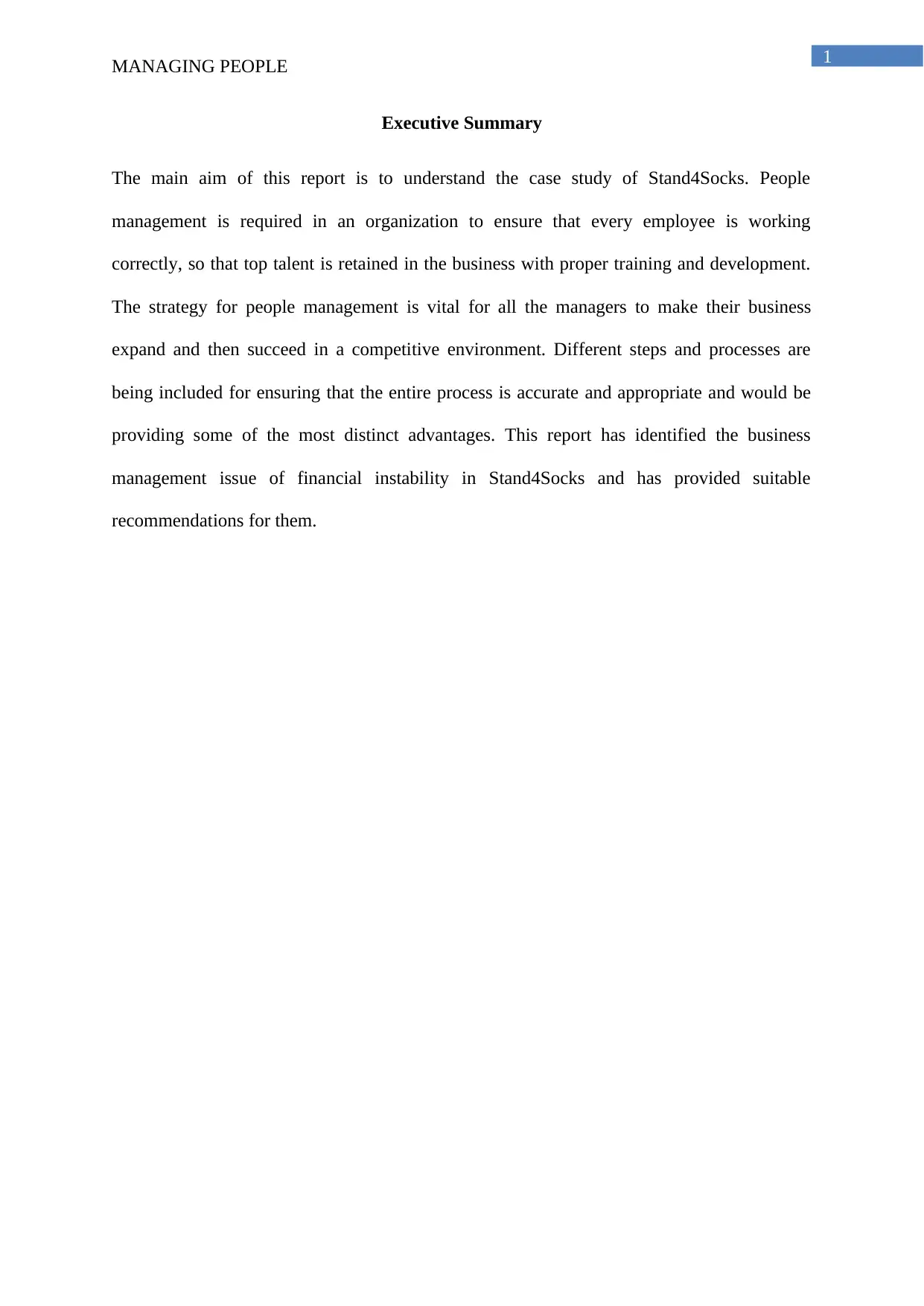
1
MANAGING PEOPLE
Executive Summary
The main aim of this report is to understand the case study of Stand4Socks. People
management is required in an organization to ensure that every employee is working
correctly, so that top talent is retained in the business with proper training and development.
The strategy for people management is vital for all the managers to make their business
expand and then succeed in a competitive environment. Different steps and processes are
being included for ensuring that the entire process is accurate and appropriate and would be
providing some of the most distinct advantages. This report has identified the business
management issue of financial instability in Stand4Socks and has provided suitable
recommendations for them.
MANAGING PEOPLE
Executive Summary
The main aim of this report is to understand the case study of Stand4Socks. People
management is required in an organization to ensure that every employee is working
correctly, so that top talent is retained in the business with proper training and development.
The strategy for people management is vital for all the managers to make their business
expand and then succeed in a competitive environment. Different steps and processes are
being included for ensuring that the entire process is accurate and appropriate and would be
providing some of the most distinct advantages. This report has identified the business
management issue of financial instability in Stand4Socks and has provided suitable
recommendations for them.
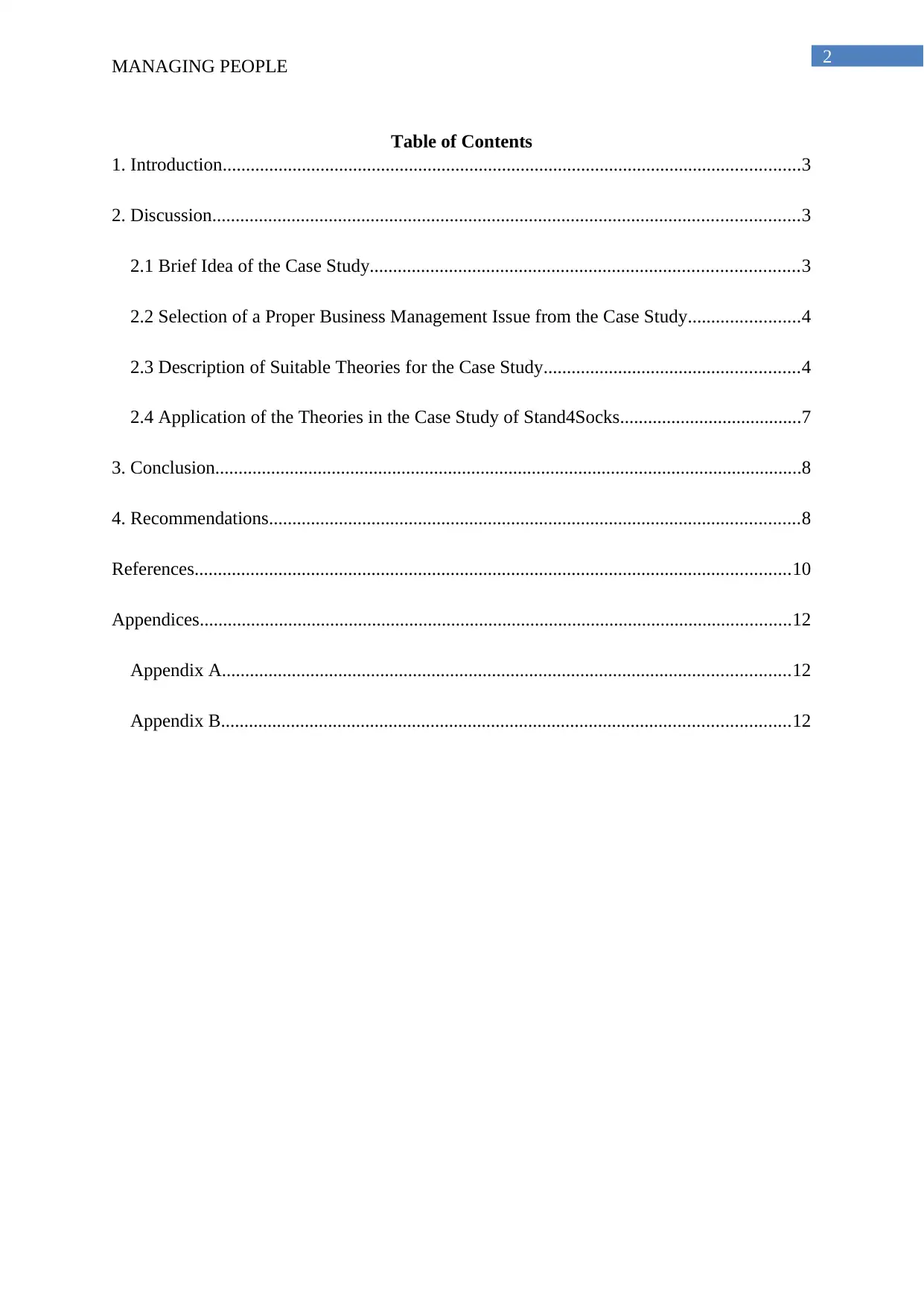
2
MANAGING PEOPLE
Table of Contents
1. Introduction............................................................................................................................3
2. Discussion..............................................................................................................................3
2.1 Brief Idea of the Case Study............................................................................................3
2.2 Selection of a Proper Business Management Issue from the Case Study........................4
2.3 Description of Suitable Theories for the Case Study.......................................................4
2.4 Application of the Theories in the Case Study of Stand4Socks.......................................7
3. Conclusion..............................................................................................................................8
4. Recommendations..................................................................................................................8
References................................................................................................................................10
Appendices...............................................................................................................................12
Appendix A..........................................................................................................................12
Appendix B..........................................................................................................................12
MANAGING PEOPLE
Table of Contents
1. Introduction............................................................................................................................3
2. Discussion..............................................................................................................................3
2.1 Brief Idea of the Case Study............................................................................................3
2.2 Selection of a Proper Business Management Issue from the Case Study........................4
2.3 Description of Suitable Theories for the Case Study.......................................................4
2.4 Application of the Theories in the Case Study of Stand4Socks.......................................7
3. Conclusion..............................................................................................................................8
4. Recommendations..................................................................................................................8
References................................................................................................................................10
Appendices...............................................................................................................................12
Appendix A..........................................................................................................................12
Appendix B..........................................................................................................................12
⊘ This is a preview!⊘
Do you want full access?
Subscribe today to unlock all pages.

Trusted by 1+ million students worldwide
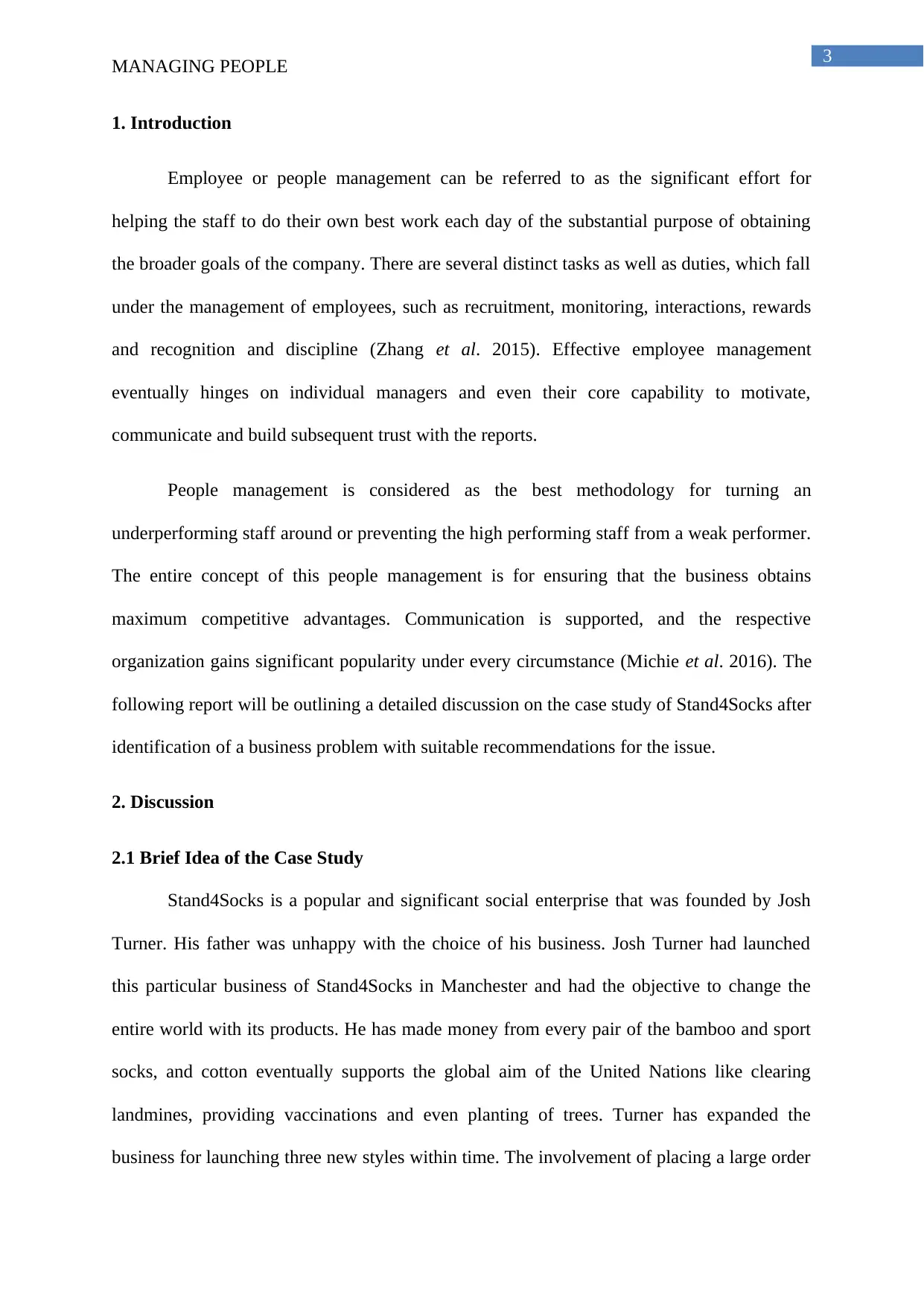
3
MANAGING PEOPLE
1. Introduction
Employee or people management can be referred to as the significant effort for
helping the staff to do their own best work each day of the substantial purpose of obtaining
the broader goals of the company. There are several distinct tasks as well as duties, which fall
under the management of employees, such as recruitment, monitoring, interactions, rewards
and recognition and discipline (Zhang et al. 2015). Effective employee management
eventually hinges on individual managers and even their core capability to motivate,
communicate and build subsequent trust with the reports.
People management is considered as the best methodology for turning an
underperforming staff around or preventing the high performing staff from a weak performer.
The entire concept of this people management is for ensuring that the business obtains
maximum competitive advantages. Communication is supported, and the respective
organization gains significant popularity under every circumstance (Michie et al. 2016). The
following report will be outlining a detailed discussion on the case study of Stand4Socks after
identification of a business problem with suitable recommendations for the issue.
2. Discussion
2.1 Brief Idea of the Case Study
Stand4Socks is a popular and significant social enterprise that was founded by Josh
Turner. His father was unhappy with the choice of his business. Josh Turner had launched
this particular business of Stand4Socks in Manchester and had the objective to change the
entire world with its products. He has made money from every pair of the bamboo and sport
socks, and cotton eventually supports the global aim of the United Nations like clearing
landmines, providing vaccinations and even planting of trees. Turner has expanded the
business for launching three new styles within time. The involvement of placing a large order
MANAGING PEOPLE
1. Introduction
Employee or people management can be referred to as the significant effort for
helping the staff to do their own best work each day of the substantial purpose of obtaining
the broader goals of the company. There are several distinct tasks as well as duties, which fall
under the management of employees, such as recruitment, monitoring, interactions, rewards
and recognition and discipline (Zhang et al. 2015). Effective employee management
eventually hinges on individual managers and even their core capability to motivate,
communicate and build subsequent trust with the reports.
People management is considered as the best methodology for turning an
underperforming staff around or preventing the high performing staff from a weak performer.
The entire concept of this people management is for ensuring that the business obtains
maximum competitive advantages. Communication is supported, and the respective
organization gains significant popularity under every circumstance (Michie et al. 2016). The
following report will be outlining a detailed discussion on the case study of Stand4Socks after
identification of a business problem with suitable recommendations for the issue.
2. Discussion
2.1 Brief Idea of the Case Study
Stand4Socks is a popular and significant social enterprise that was founded by Josh
Turner. His father was unhappy with the choice of his business. Josh Turner had launched
this particular business of Stand4Socks in Manchester and had the objective to change the
entire world with its products. He has made money from every pair of the bamboo and sport
socks, and cotton eventually supports the global aim of the United Nations like clearing
landmines, providing vaccinations and even planting of trees. Turner has expanded the
business for launching three new styles within time. The involvement of placing a large order
Paraphrase This Document
Need a fresh take? Get an instant paraphrase of this document with our AI Paraphraser
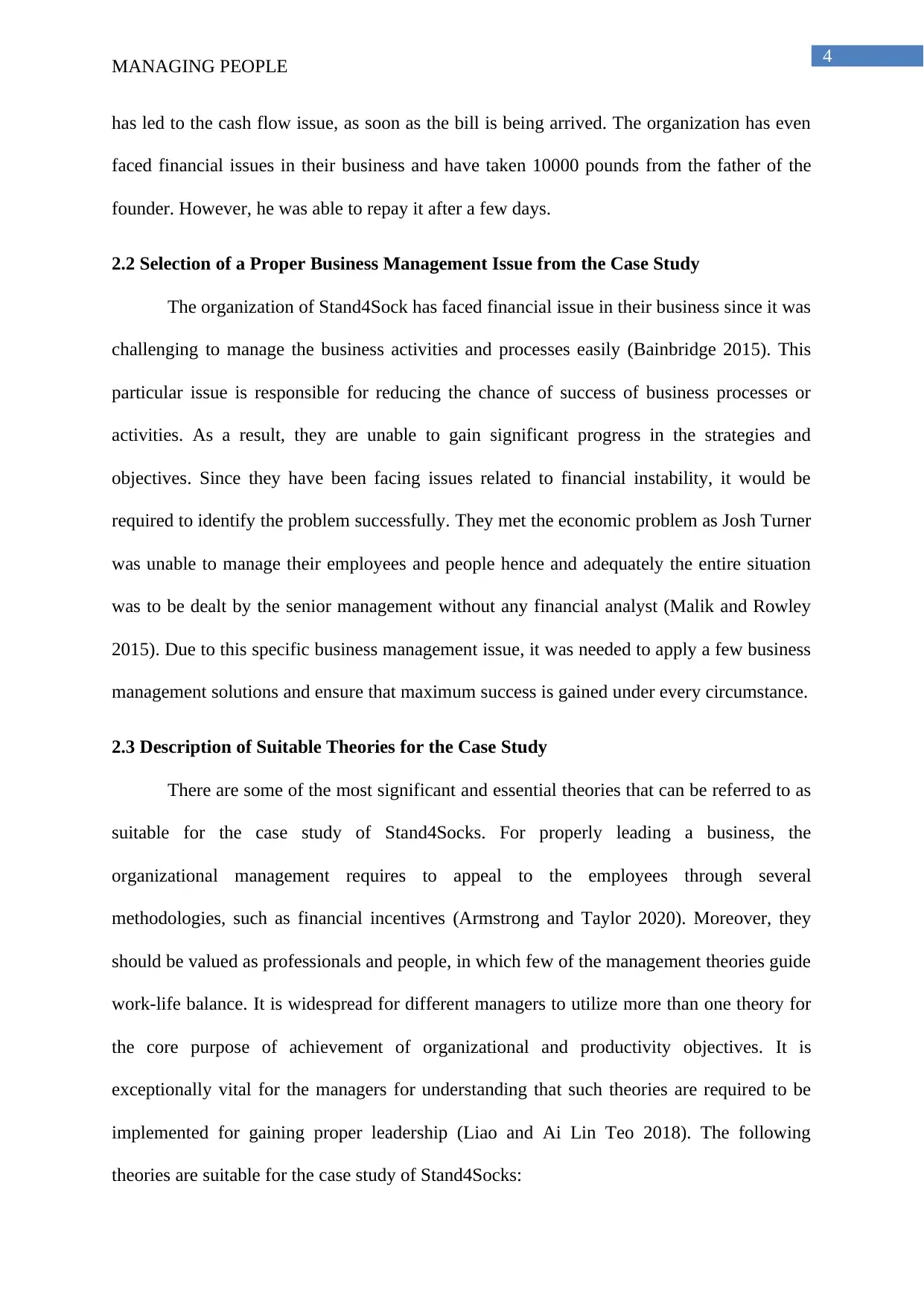
4
MANAGING PEOPLE
has led to the cash flow issue, as soon as the bill is being arrived. The organization has even
faced financial issues in their business and have taken 10000 pounds from the father of the
founder. However, he was able to repay it after a few days.
2.2 Selection of a Proper Business Management Issue from the Case Study
The organization of Stand4Sock has faced financial issue in their business since it was
challenging to manage the business activities and processes easily (Bainbridge 2015). This
particular issue is responsible for reducing the chance of success of business processes or
activities. As a result, they are unable to gain significant progress in the strategies and
objectives. Since they have been facing issues related to financial instability, it would be
required to identify the problem successfully. They met the economic problem as Josh Turner
was unable to manage their employees and people hence and adequately the entire situation
was to be dealt by the senior management without any financial analyst (Malik and Rowley
2015). Due to this specific business management issue, it was needed to apply a few business
management solutions and ensure that maximum success is gained under every circumstance.
2.3 Description of Suitable Theories for the Case Study
There are some of the most significant and essential theories that can be referred to as
suitable for the case study of Stand4Socks. For properly leading a business, the
organizational management requires to appeal to the employees through several
methodologies, such as financial incentives (Armstrong and Taylor 2020). Moreover, they
should be valued as professionals and people, in which few of the management theories guide
work-life balance. It is widespread for different managers to utilize more than one theory for
the core purpose of achievement of organizational and productivity objectives. It is
exceptionally vital for the managers for understanding that such theories are required to be
implemented for gaining proper leadership (Liao and Ai Lin Teo 2018). The following
theories are suitable for the case study of Stand4Socks:
MANAGING PEOPLE
has led to the cash flow issue, as soon as the bill is being arrived. The organization has even
faced financial issues in their business and have taken 10000 pounds from the father of the
founder. However, he was able to repay it after a few days.
2.2 Selection of a Proper Business Management Issue from the Case Study
The organization of Stand4Sock has faced financial issue in their business since it was
challenging to manage the business activities and processes easily (Bainbridge 2015). This
particular issue is responsible for reducing the chance of success of business processes or
activities. As a result, they are unable to gain significant progress in the strategies and
objectives. Since they have been facing issues related to financial instability, it would be
required to identify the problem successfully. They met the economic problem as Josh Turner
was unable to manage their employees and people hence and adequately the entire situation
was to be dealt by the senior management without any financial analyst (Malik and Rowley
2015). Due to this specific business management issue, it was needed to apply a few business
management solutions and ensure that maximum success is gained under every circumstance.
2.3 Description of Suitable Theories for the Case Study
There are some of the most significant and essential theories that can be referred to as
suitable for the case study of Stand4Socks. For properly leading a business, the
organizational management requires to appeal to the employees through several
methodologies, such as financial incentives (Armstrong and Taylor 2020). Moreover, they
should be valued as professionals and people, in which few of the management theories guide
work-life balance. It is widespread for different managers to utilize more than one theory for
the core purpose of achievement of organizational and productivity objectives. It is
exceptionally vital for the managers for understanding that such theories are required to be
implemented for gaining proper leadership (Liao and Ai Lin Teo 2018). The following
theories are suitable for the case study of Stand4Socks:
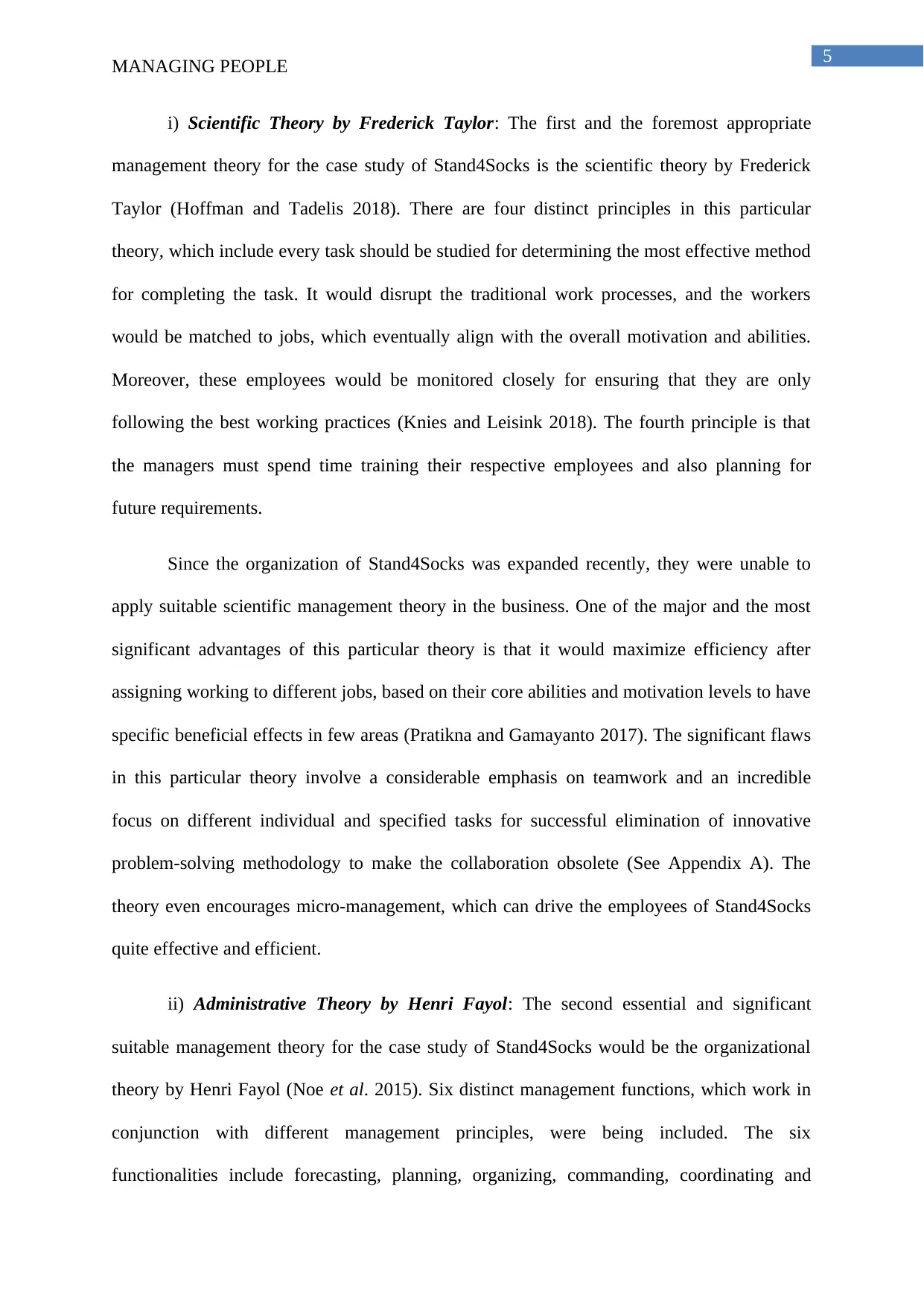
5
MANAGING PEOPLE
i) Scientific Theory by Frederick Taylor: The first and the foremost appropriate
management theory for the case study of Stand4Socks is the scientific theory by Frederick
Taylor (Hoffman and Tadelis 2018). There are four distinct principles in this particular
theory, which include every task should be studied for determining the most effective method
for completing the task. It would disrupt the traditional work processes, and the workers
would be matched to jobs, which eventually align with the overall motivation and abilities.
Moreover, these employees would be monitored closely for ensuring that they are only
following the best working practices (Knies and Leisink 2018). The fourth principle is that
the managers must spend time training their respective employees and also planning for
future requirements.
Since the organization of Stand4Socks was expanded recently, they were unable to
apply suitable scientific management theory in the business. One of the major and the most
significant advantages of this particular theory is that it would maximize efficiency after
assigning working to different jobs, based on their core abilities and motivation levels to have
specific beneficial effects in few areas (Pratikna and Gamayanto 2017). The significant flaws
in this particular theory involve a considerable emphasis on teamwork and an incredible
focus on different individual and specified tasks for successful elimination of innovative
problem-solving methodology to make the collaboration obsolete (See Appendix A). The
theory even encourages micro-management, which can drive the employees of Stand4Socks
quite effective and efficient.
ii) Administrative Theory by Henri Fayol: The second essential and significant
suitable management theory for the case study of Stand4Socks would be the organizational
theory by Henri Fayol (Noe et al. 2015). Six distinct management functions, which work in
conjunction with different management principles, were being included. The six
functionalities include forecasting, planning, organizing, commanding, coordinating and
MANAGING PEOPLE
i) Scientific Theory by Frederick Taylor: The first and the foremost appropriate
management theory for the case study of Stand4Socks is the scientific theory by Frederick
Taylor (Hoffman and Tadelis 2018). There are four distinct principles in this particular
theory, which include every task should be studied for determining the most effective method
for completing the task. It would disrupt the traditional work processes, and the workers
would be matched to jobs, which eventually align with the overall motivation and abilities.
Moreover, these employees would be monitored closely for ensuring that they are only
following the best working practices (Knies and Leisink 2018). The fourth principle is that
the managers must spend time training their respective employees and also planning for
future requirements.
Since the organization of Stand4Socks was expanded recently, they were unable to
apply suitable scientific management theory in the business. One of the major and the most
significant advantages of this particular theory is that it would maximize efficiency after
assigning working to different jobs, based on their core abilities and motivation levels to have
specific beneficial effects in few areas (Pratikna and Gamayanto 2017). The significant flaws
in this particular theory involve a considerable emphasis on teamwork and an incredible
focus on different individual and specified tasks for successful elimination of innovative
problem-solving methodology to make the collaboration obsolete (See Appendix A). The
theory even encourages micro-management, which can drive the employees of Stand4Socks
quite effective and efficient.
ii) Administrative Theory by Henri Fayol: The second essential and significant
suitable management theory for the case study of Stand4Socks would be the organizational
theory by Henri Fayol (Noe et al. 2015). Six distinct management functions, which work in
conjunction with different management principles, were being included. The six
functionalities include forecasting, planning, organizing, commanding, coordinating and
⊘ This is a preview!⊘
Do you want full access?
Subscribe today to unlock all pages.

Trusted by 1+ million students worldwide
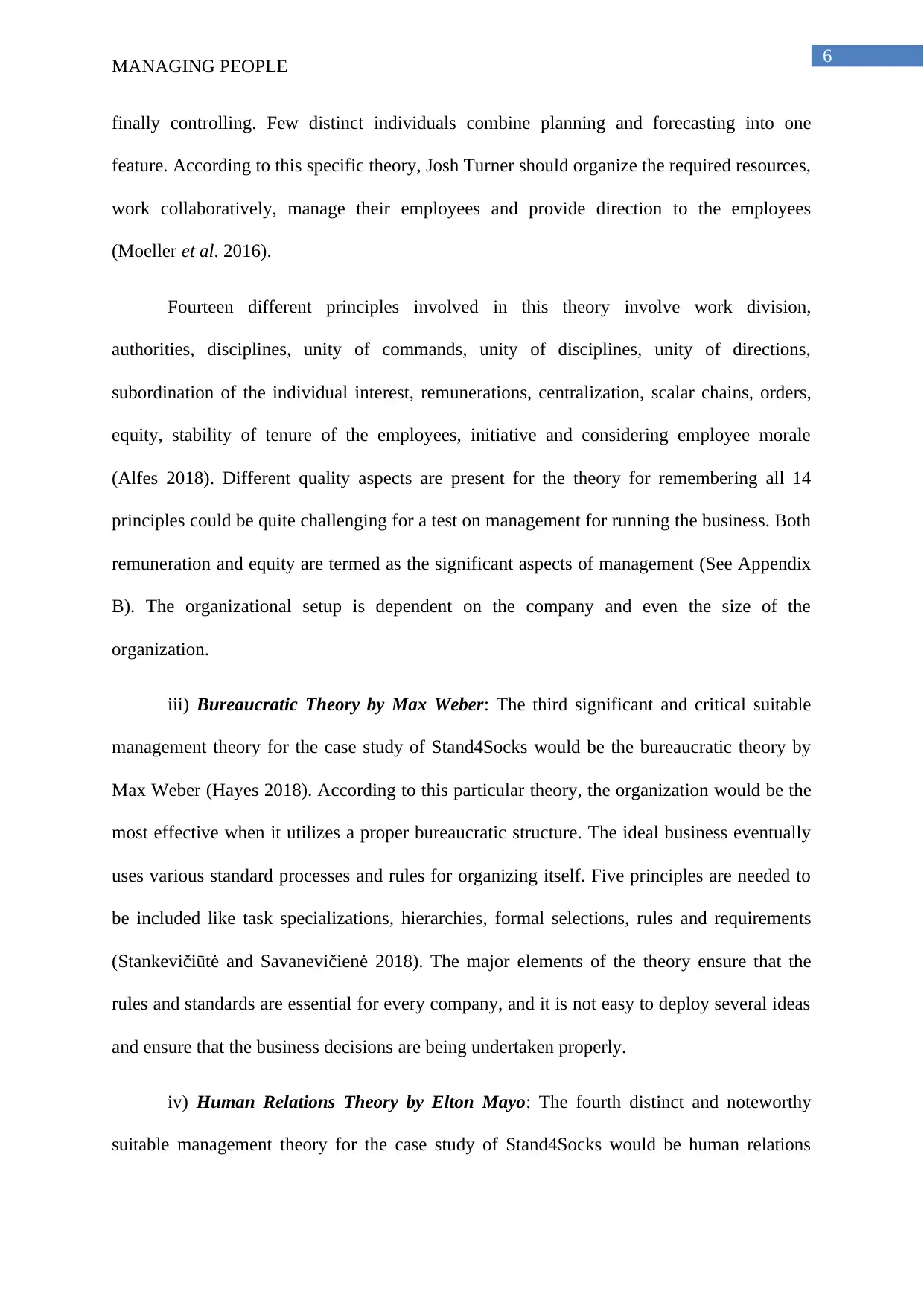
6
MANAGING PEOPLE
finally controlling. Few distinct individuals combine planning and forecasting into one
feature. According to this specific theory, Josh Turner should organize the required resources,
work collaboratively, manage their employees and provide direction to the employees
(Moeller et al. 2016).
Fourteen different principles involved in this theory involve work division,
authorities, disciplines, unity of commands, unity of disciplines, unity of directions,
subordination of the individual interest, remunerations, centralization, scalar chains, orders,
equity, stability of tenure of the employees, initiative and considering employee morale
(Alfes 2018). Different quality aspects are present for the theory for remembering all 14
principles could be quite challenging for a test on management for running the business. Both
remuneration and equity are termed as the significant aspects of management (See Appendix
B). The organizational setup is dependent on the company and even the size of the
organization.
iii) Bureaucratic Theory by Max Weber: The third significant and critical suitable
management theory for the case study of Stand4Socks would be the bureaucratic theory by
Max Weber (Hayes 2018). According to this particular theory, the organization would be the
most effective when it utilizes a proper bureaucratic structure. The ideal business eventually
uses various standard processes and rules for organizing itself. Five principles are needed to
be included like task specializations, hierarchies, formal selections, rules and requirements
(Stankevičiūtė and Savanevičienė 2018). The major elements of the theory ensure that the
rules and standards are essential for every company, and it is not easy to deploy several ideas
and ensure that the business decisions are being undertaken properly.
iv) Human Relations Theory by Elton Mayo: The fourth distinct and noteworthy
suitable management theory for the case study of Stand4Socks would be human relations
MANAGING PEOPLE
finally controlling. Few distinct individuals combine planning and forecasting into one
feature. According to this specific theory, Josh Turner should organize the required resources,
work collaboratively, manage their employees and provide direction to the employees
(Moeller et al. 2016).
Fourteen different principles involved in this theory involve work division,
authorities, disciplines, unity of commands, unity of disciplines, unity of directions,
subordination of the individual interest, remunerations, centralization, scalar chains, orders,
equity, stability of tenure of the employees, initiative and considering employee morale
(Alfes 2018). Different quality aspects are present for the theory for remembering all 14
principles could be quite challenging for a test on management for running the business. Both
remuneration and equity are termed as the significant aspects of management (See Appendix
B). The organizational setup is dependent on the company and even the size of the
organization.
iii) Bureaucratic Theory by Max Weber: The third significant and critical suitable
management theory for the case study of Stand4Socks would be the bureaucratic theory by
Max Weber (Hayes 2018). According to this particular theory, the organization would be the
most effective when it utilizes a proper bureaucratic structure. The ideal business eventually
uses various standard processes and rules for organizing itself. Five principles are needed to
be included like task specializations, hierarchies, formal selections, rules and requirements
(Stankevičiūtė and Savanevičienė 2018). The major elements of the theory ensure that the
rules and standards are essential for every company, and it is not easy to deploy several ideas
and ensure that the business decisions are being undertaken properly.
iv) Human Relations Theory by Elton Mayo: The fourth distinct and noteworthy
suitable management theory for the case study of Stand4Socks would be human relations
Paraphrase This Document
Need a fresh take? Get an instant paraphrase of this document with our AI Paraphraser
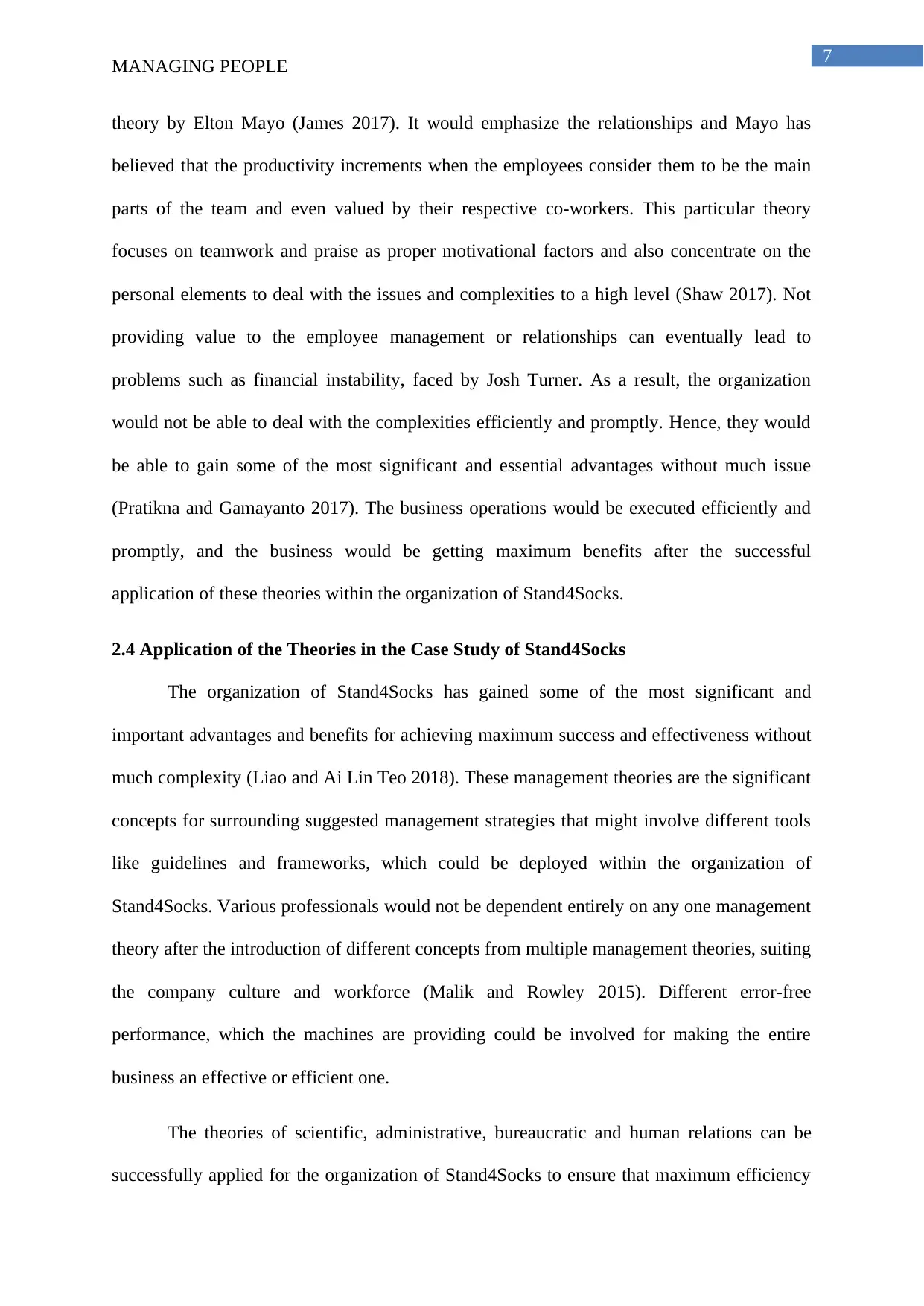
7
MANAGING PEOPLE
theory by Elton Mayo (James 2017). It would emphasize the relationships and Mayo has
believed that the productivity increments when the employees consider them to be the main
parts of the team and even valued by their respective co-workers. This particular theory
focuses on teamwork and praise as proper motivational factors and also concentrate on the
personal elements to deal with the issues and complexities to a high level (Shaw 2017). Not
providing value to the employee management or relationships can eventually lead to
problems such as financial instability, faced by Josh Turner. As a result, the organization
would not be able to deal with the complexities efficiently and promptly. Hence, they would
be able to gain some of the most significant and essential advantages without much issue
(Pratikna and Gamayanto 2017). The business operations would be executed efficiently and
promptly, and the business would be getting maximum benefits after the successful
application of these theories within the organization of Stand4Socks.
2.4 Application of the Theories in the Case Study of Stand4Socks
The organization of Stand4Socks has gained some of the most significant and
important advantages and benefits for achieving maximum success and effectiveness without
much complexity (Liao and Ai Lin Teo 2018). These management theories are the significant
concepts for surrounding suggested management strategies that might involve different tools
like guidelines and frameworks, which could be deployed within the organization of
Stand4Socks. Various professionals would not be dependent entirely on any one management
theory after the introduction of different concepts from multiple management theories, suiting
the company culture and workforce (Malik and Rowley 2015). Different error-free
performance, which the machines are providing could be involved for making the entire
business an effective or efficient one.
The theories of scientific, administrative, bureaucratic and human relations can be
successfully applied for the organization of Stand4Socks to ensure that maximum efficiency
MANAGING PEOPLE
theory by Elton Mayo (James 2017). It would emphasize the relationships and Mayo has
believed that the productivity increments when the employees consider them to be the main
parts of the team and even valued by their respective co-workers. This particular theory
focuses on teamwork and praise as proper motivational factors and also concentrate on the
personal elements to deal with the issues and complexities to a high level (Shaw 2017). Not
providing value to the employee management or relationships can eventually lead to
problems such as financial instability, faced by Josh Turner. As a result, the organization
would not be able to deal with the complexities efficiently and promptly. Hence, they would
be able to gain some of the most significant and essential advantages without much issue
(Pratikna and Gamayanto 2017). The business operations would be executed efficiently and
promptly, and the business would be getting maximum benefits after the successful
application of these theories within the organization of Stand4Socks.
2.4 Application of the Theories in the Case Study of Stand4Socks
The organization of Stand4Socks has gained some of the most significant and
important advantages and benefits for achieving maximum success and effectiveness without
much complexity (Liao and Ai Lin Teo 2018). These management theories are the significant
concepts for surrounding suggested management strategies that might involve different tools
like guidelines and frameworks, which could be deployed within the organization of
Stand4Socks. Various professionals would not be dependent entirely on any one management
theory after the introduction of different concepts from multiple management theories, suiting
the company culture and workforce (Malik and Rowley 2015). Different error-free
performance, which the machines are providing could be involved for making the entire
business an effective or efficient one.
The theories of scientific, administrative, bureaucratic and human relations can be
successfully applied for the organization of Stand4Socks to ensure that maximum efficiency
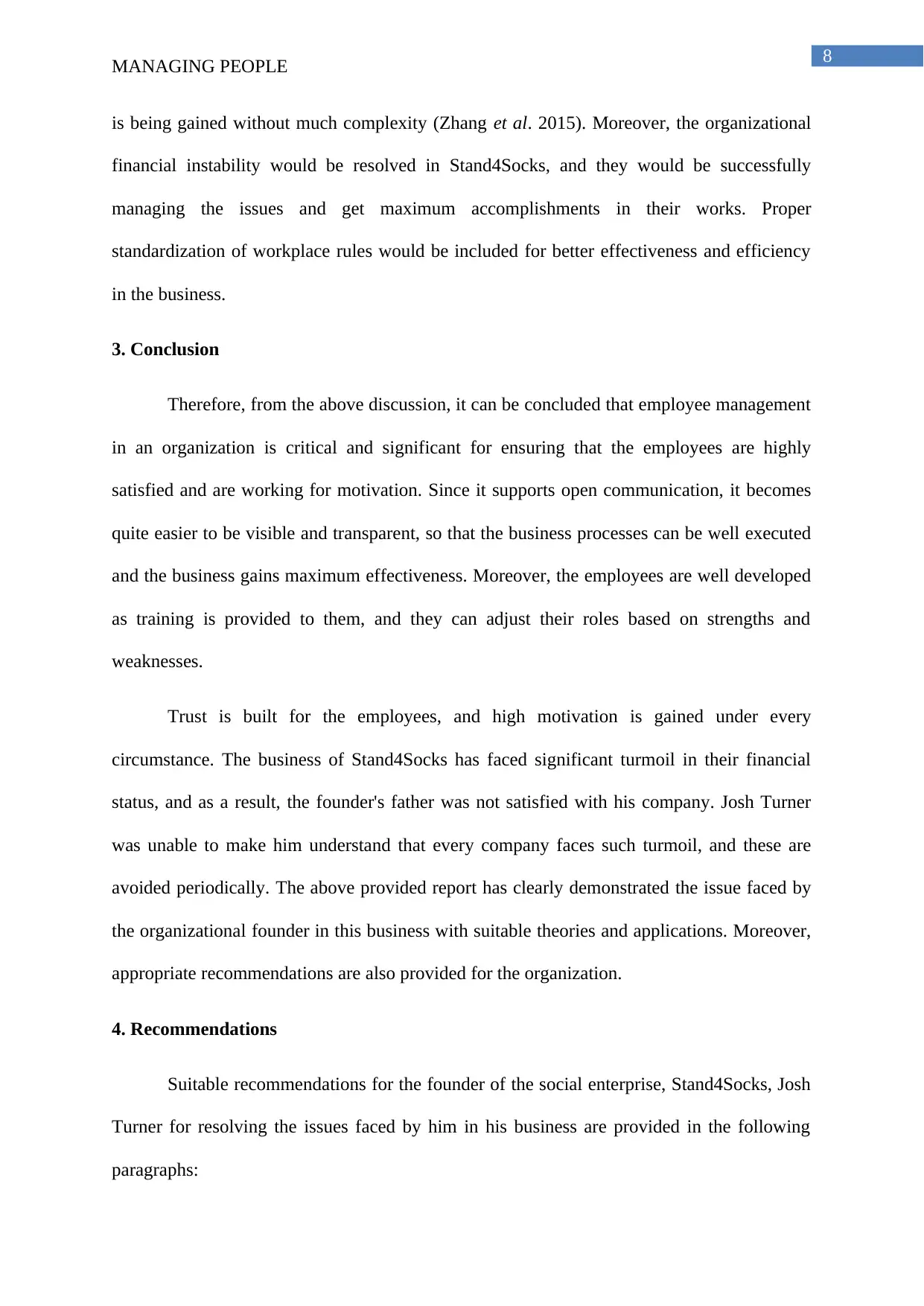
8
MANAGING PEOPLE
is being gained without much complexity (Zhang et al. 2015). Moreover, the organizational
financial instability would be resolved in Stand4Socks, and they would be successfully
managing the issues and get maximum accomplishments in their works. Proper
standardization of workplace rules would be included for better effectiveness and efficiency
in the business.
3. Conclusion
Therefore, from the above discussion, it can be concluded that employee management
in an organization is critical and significant for ensuring that the employees are highly
satisfied and are working for motivation. Since it supports open communication, it becomes
quite easier to be visible and transparent, so that the business processes can be well executed
and the business gains maximum effectiveness. Moreover, the employees are well developed
as training is provided to them, and they can adjust their roles based on strengths and
weaknesses.
Trust is built for the employees, and high motivation is gained under every
circumstance. The business of Stand4Socks has faced significant turmoil in their financial
status, and as a result, the founder's father was not satisfied with his company. Josh Turner
was unable to make him understand that every company faces such turmoil, and these are
avoided periodically. The above provided report has clearly demonstrated the issue faced by
the organizational founder in this business with suitable theories and applications. Moreover,
appropriate recommendations are also provided for the organization.
4. Recommendations
Suitable recommendations for the founder of the social enterprise, Stand4Socks, Josh
Turner for resolving the issues faced by him in his business are provided in the following
paragraphs:
MANAGING PEOPLE
is being gained without much complexity (Zhang et al. 2015). Moreover, the organizational
financial instability would be resolved in Stand4Socks, and they would be successfully
managing the issues and get maximum accomplishments in their works. Proper
standardization of workplace rules would be included for better effectiveness and efficiency
in the business.
3. Conclusion
Therefore, from the above discussion, it can be concluded that employee management
in an organization is critical and significant for ensuring that the employees are highly
satisfied and are working for motivation. Since it supports open communication, it becomes
quite easier to be visible and transparent, so that the business processes can be well executed
and the business gains maximum effectiveness. Moreover, the employees are well developed
as training is provided to them, and they can adjust their roles based on strengths and
weaknesses.
Trust is built for the employees, and high motivation is gained under every
circumstance. The business of Stand4Socks has faced significant turmoil in their financial
status, and as a result, the founder's father was not satisfied with his company. Josh Turner
was unable to make him understand that every company faces such turmoil, and these are
avoided periodically. The above provided report has clearly demonstrated the issue faced by
the organizational founder in this business with suitable theories and applications. Moreover,
appropriate recommendations are also provided for the organization.
4. Recommendations
Suitable recommendations for the founder of the social enterprise, Stand4Socks, Josh
Turner for resolving the issues faced by him in his business are provided in the following
paragraphs:
⊘ This is a preview!⊘
Do you want full access?
Subscribe today to unlock all pages.

Trusted by 1+ million students worldwide
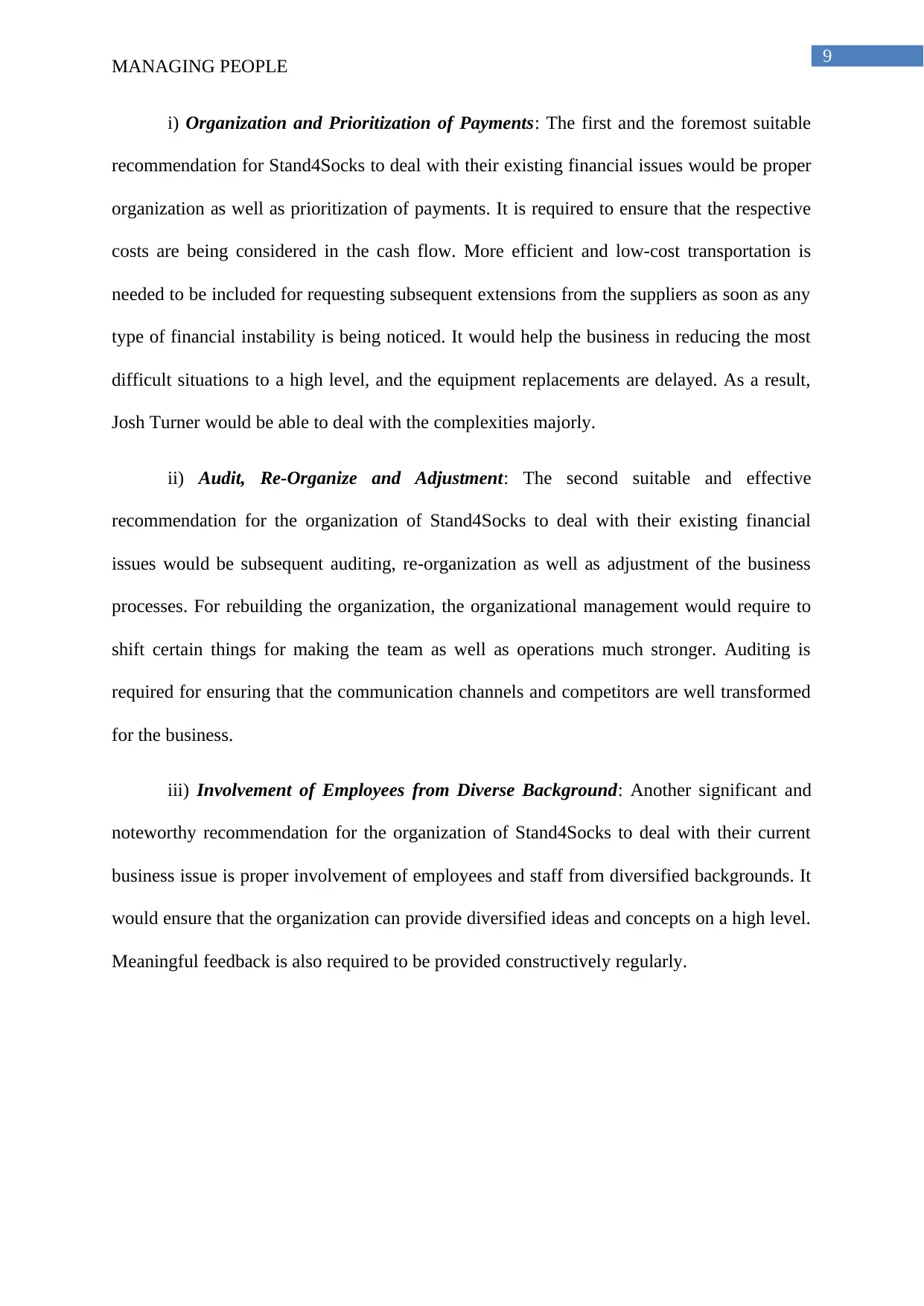
9
MANAGING PEOPLE
i) Organization and Prioritization of Payments: The first and the foremost suitable
recommendation for Stand4Socks to deal with their existing financial issues would be proper
organization as well as prioritization of payments. It is required to ensure that the respective
costs are being considered in the cash flow. More efficient and low-cost transportation is
needed to be included for requesting subsequent extensions from the suppliers as soon as any
type of financial instability is being noticed. It would help the business in reducing the most
difficult situations to a high level, and the equipment replacements are delayed. As a result,
Josh Turner would be able to deal with the complexities majorly.
ii) Audit, Re-Organize and Adjustment: The second suitable and effective
recommendation for the organization of Stand4Socks to deal with their existing financial
issues would be subsequent auditing, re-organization as well as adjustment of the business
processes. For rebuilding the organization, the organizational management would require to
shift certain things for making the team as well as operations much stronger. Auditing is
required for ensuring that the communication channels and competitors are well transformed
for the business.
iii) Involvement of Employees from Diverse Background: Another significant and
noteworthy recommendation for the organization of Stand4Socks to deal with their current
business issue is proper involvement of employees and staff from diversified backgrounds. It
would ensure that the organization can provide diversified ideas and concepts on a high level.
Meaningful feedback is also required to be provided constructively regularly.
MANAGING PEOPLE
i) Organization and Prioritization of Payments: The first and the foremost suitable
recommendation for Stand4Socks to deal with their existing financial issues would be proper
organization as well as prioritization of payments. It is required to ensure that the respective
costs are being considered in the cash flow. More efficient and low-cost transportation is
needed to be included for requesting subsequent extensions from the suppliers as soon as any
type of financial instability is being noticed. It would help the business in reducing the most
difficult situations to a high level, and the equipment replacements are delayed. As a result,
Josh Turner would be able to deal with the complexities majorly.
ii) Audit, Re-Organize and Adjustment: The second suitable and effective
recommendation for the organization of Stand4Socks to deal with their existing financial
issues would be subsequent auditing, re-organization as well as adjustment of the business
processes. For rebuilding the organization, the organizational management would require to
shift certain things for making the team as well as operations much stronger. Auditing is
required for ensuring that the communication channels and competitors are well transformed
for the business.
iii) Involvement of Employees from Diverse Background: Another significant and
noteworthy recommendation for the organization of Stand4Socks to deal with their current
business issue is proper involvement of employees and staff from diversified backgrounds. It
would ensure that the organization can provide diversified ideas and concepts on a high level.
Meaningful feedback is also required to be provided constructively regularly.
Paraphrase This Document
Need a fresh take? Get an instant paraphrase of this document with our AI Paraphraser
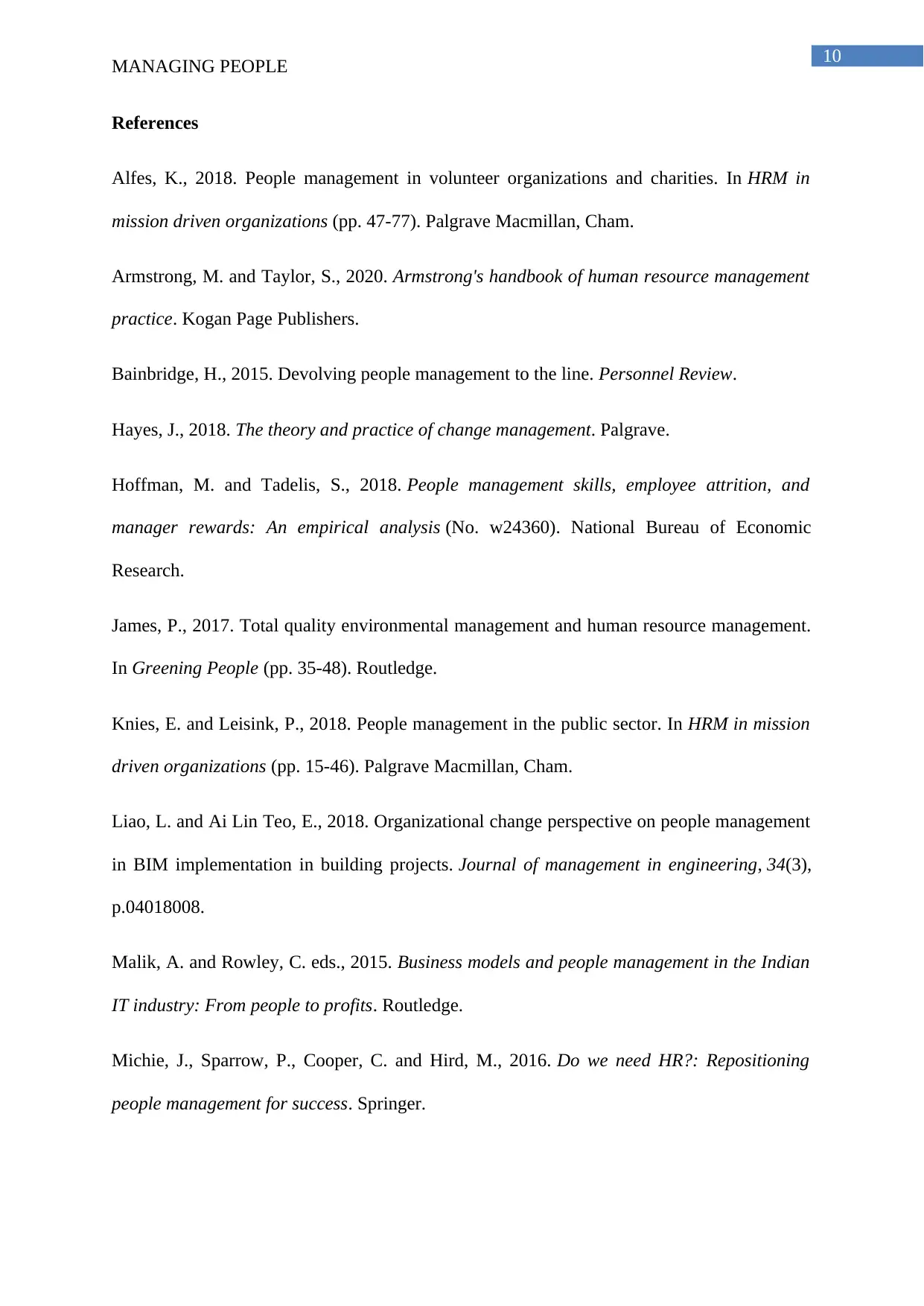
10
MANAGING PEOPLE
References
Alfes, K., 2018. People management in volunteer organizations and charities. In HRM in
mission driven organizations (pp. 47-77). Palgrave Macmillan, Cham.
Armstrong, M. and Taylor, S., 2020. Armstrong's handbook of human resource management
practice. Kogan Page Publishers.
Bainbridge, H., 2015. Devolving people management to the line. Personnel Review.
Hayes, J., 2018. The theory and practice of change management. Palgrave.
Hoffman, M. and Tadelis, S., 2018. People management skills, employee attrition, and
manager rewards: An empirical analysis (No. w24360). National Bureau of Economic
Research.
James, P., 2017. Total quality environmental management and human resource management.
In Greening People (pp. 35-48). Routledge.
Knies, E. and Leisink, P., 2018. People management in the public sector. In HRM in mission
driven organizations (pp. 15-46). Palgrave Macmillan, Cham.
Liao, L. and Ai Lin Teo, E., 2018. Organizational change perspective on people management
in BIM implementation in building projects. Journal of management in engineering, 34(3),
p.04018008.
Malik, A. and Rowley, C. eds., 2015. Business models and people management in the Indian
IT industry: From people to profits. Routledge.
Michie, J., Sparrow, P., Cooper, C. and Hird, M., 2016. Do we need HR?: Repositioning
people management for success. Springer.
MANAGING PEOPLE
References
Alfes, K., 2018. People management in volunteer organizations and charities. In HRM in
mission driven organizations (pp. 47-77). Palgrave Macmillan, Cham.
Armstrong, M. and Taylor, S., 2020. Armstrong's handbook of human resource management
practice. Kogan Page Publishers.
Bainbridge, H., 2015. Devolving people management to the line. Personnel Review.
Hayes, J., 2018. The theory and practice of change management. Palgrave.
Hoffman, M. and Tadelis, S., 2018. People management skills, employee attrition, and
manager rewards: An empirical analysis (No. w24360). National Bureau of Economic
Research.
James, P., 2017. Total quality environmental management and human resource management.
In Greening People (pp. 35-48). Routledge.
Knies, E. and Leisink, P., 2018. People management in the public sector. In HRM in mission
driven organizations (pp. 15-46). Palgrave Macmillan, Cham.
Liao, L. and Ai Lin Teo, E., 2018. Organizational change perspective on people management
in BIM implementation in building projects. Journal of management in engineering, 34(3),
p.04018008.
Malik, A. and Rowley, C. eds., 2015. Business models and people management in the Indian
IT industry: From people to profits. Routledge.
Michie, J., Sparrow, P., Cooper, C. and Hird, M., 2016. Do we need HR?: Repositioning
people management for success. Springer.
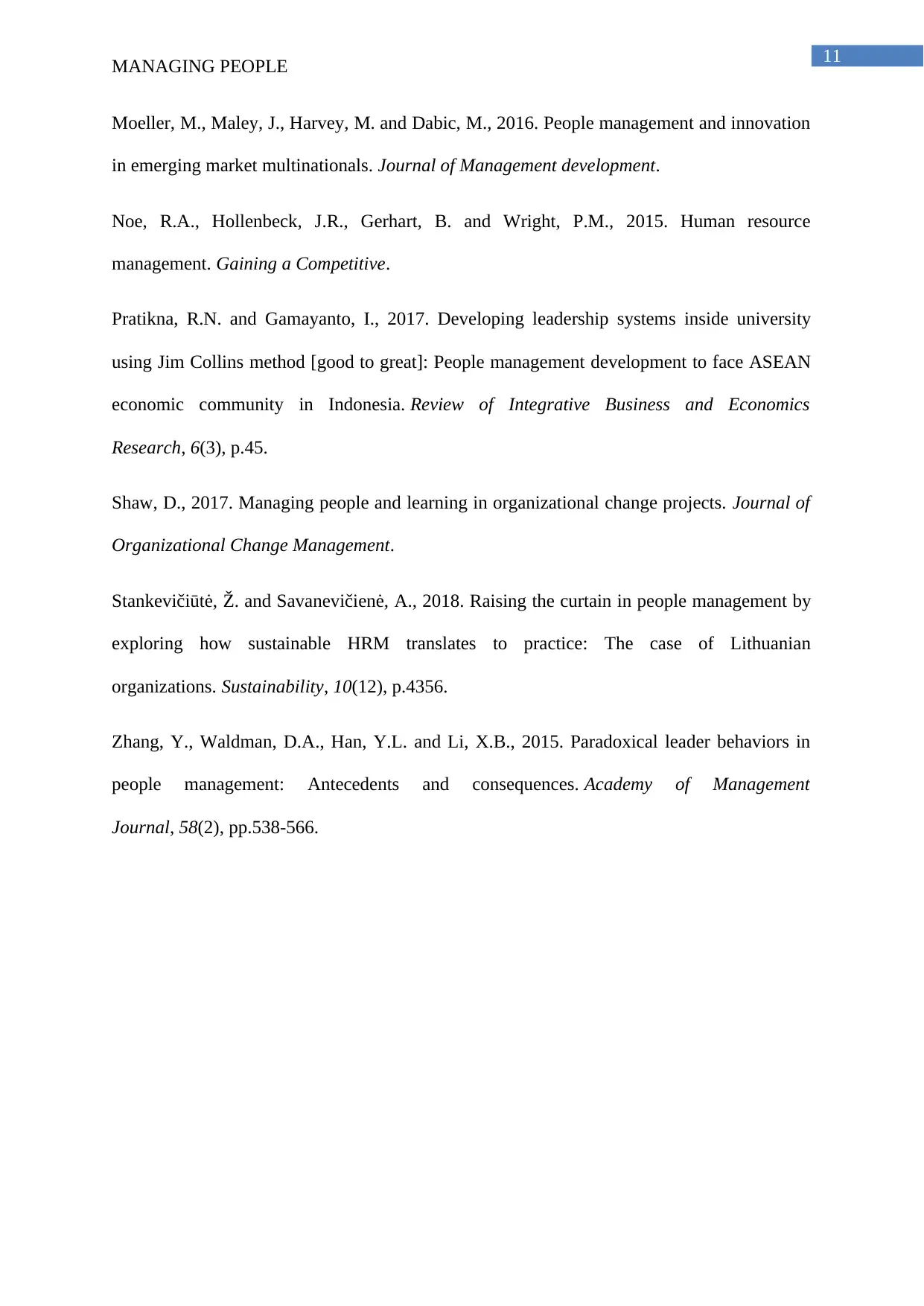
11
MANAGING PEOPLE
Moeller, M., Maley, J., Harvey, M. and Dabic, M., 2016. People management and innovation
in emerging market multinationals. Journal of Management development.
Noe, R.A., Hollenbeck, J.R., Gerhart, B. and Wright, P.M., 2015. Human resource
management. Gaining a Competitive.
Pratikna, R.N. and Gamayanto, I., 2017. Developing leadership systems inside university
using Jim Collins method [good to great]: People management development to face ASEAN
economic community in Indonesia. Review of Integrative Business and Economics
Research, 6(3), p.45.
Shaw, D., 2017. Managing people and learning in organizational change projects. Journal of
Organizational Change Management.
Stankevičiūtė, Ž. and Savanevičienė, A., 2018. Raising the curtain in people management by
exploring how sustainable HRM translates to practice: The case of Lithuanian
organizations. Sustainability, 10(12), p.4356.
Zhang, Y., Waldman, D.A., Han, Y.L. and Li, X.B., 2015. Paradoxical leader behaviors in
people management: Antecedents and consequences. Academy of Management
Journal, 58(2), pp.538-566.
MANAGING PEOPLE
Moeller, M., Maley, J., Harvey, M. and Dabic, M., 2016. People management and innovation
in emerging market multinationals. Journal of Management development.
Noe, R.A., Hollenbeck, J.R., Gerhart, B. and Wright, P.M., 2015. Human resource
management. Gaining a Competitive.
Pratikna, R.N. and Gamayanto, I., 2017. Developing leadership systems inside university
using Jim Collins method [good to great]: People management development to face ASEAN
economic community in Indonesia. Review of Integrative Business and Economics
Research, 6(3), p.45.
Shaw, D., 2017. Managing people and learning in organizational change projects. Journal of
Organizational Change Management.
Stankevičiūtė, Ž. and Savanevičienė, A., 2018. Raising the curtain in people management by
exploring how sustainable HRM translates to practice: The case of Lithuanian
organizations. Sustainability, 10(12), p.4356.
Zhang, Y., Waldman, D.A., Han, Y.L. and Li, X.B., 2015. Paradoxical leader behaviors in
people management: Antecedents and consequences. Academy of Management
Journal, 58(2), pp.538-566.
⊘ This is a preview!⊘
Do you want full access?
Subscribe today to unlock all pages.

Trusted by 1+ million students worldwide
1 out of 13
Related Documents
Your All-in-One AI-Powered Toolkit for Academic Success.
+13062052269
info@desklib.com
Available 24*7 on WhatsApp / Email
![[object Object]](/_next/static/media/star-bottom.7253800d.svg)
Unlock your academic potential
Copyright © 2020–2025 A2Z Services. All Rights Reserved. Developed and managed by ZUCOL.





